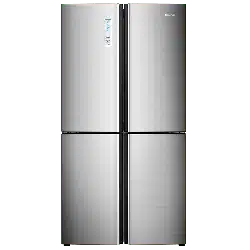Documents: Go to download!
User Manual
- User Manual - (English, Spanish)
- Spec Sheet - (English)
- Spec Sheet (web) - (English)
- Dimensions Guide - (English)
- Energy Guide - (English)
- Parts and Features
- Installation Requirements
- Installation Instructions
- Refrigerator Use
- Features
- Refrigerator Care
- Troubleshooting
Table of contents
Use & Care Guide Refrigerator for Hisense HQD20058SV
Parts and Features

a Door Bin
b Mullion
c Refrigerator LED Light
d Door Tray
e Ice Maker
f Freezer LED Light
g Ice Storage Container
h Freezer Drawer
i Freezer Compartment
j Convertible Compartment
k Glass Shelf
l Cover
m Storage Drawer
n Full-width Drawer
o Glass Shelf
p Convertible Drawer
q Leveling Leg
NOTE: Your model may look different from this and other images in this manual, depending on your model’s features.
Installation Requirements
Location Requirements
Explosion and Fire Hazard: Keep flammable materials and vapors, such as gasoline, away from appliance. Failure to do so can result in death, explosion or fire
IMPORTANT: This refrigerator is designed for indoor, household use only.
Temperature: This refrigerator is intended for use in a location where the temperature ranges from a minimum of 55°F (13°C) to a maximum of 110°F (43°C). The preferred room temperature range for optimum performance, which reduces electricity usage and provides superior cooling, is between 60°F (15°C) and 90°F (32°C). It is recommended that you do not install the refrigerator near a heat source, such as an oven or radiator.
Ventilation
- Adequate air circulation around the refrigerator is required for efficient operation.
- To ensure proper ventilation, maintain the recommended clearances
Recommended Clearances
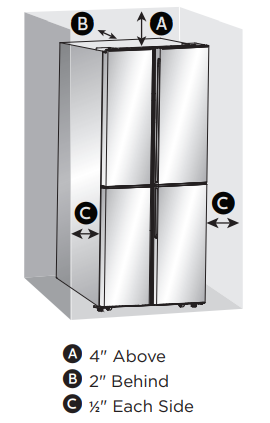
NOTE: If you place the refrigerator next to a fixed wall, leave 4" (10 cm) minimum space to allow the door to swing open.
Electrical Requirements
Electrical Shock Hazard: Plug into a grounded 3 prong outlet. Do not remove the ground prong from the power cord plug. Do not use an adapter. Do not use an extension cord. Failure to do so can result in death, fire or electrical shock.
Before you move your refrigerator into its final location, it is important to make sure you have the proper electrical connection.
Recommended
- Grounding Method A 115 volt, 60 Hz, AC only 15- or 20-amp fused, grounded electrical supply is required. It is recommended that a separate circuit serving only your refrigerator be provided. Use an outlet that cannot be turned off by a switch. Do not use an extension cord.
- NOTE: Before performing any type of installation or cleaning, disconnect the refrigerator from the electrical source. When you are finished, reconnect the refrigerator to the electrical source and reset the temperature controls to the desired setting.
Water Supply Requirements
- A cold water supply with water pressure between 30 and 125 psi (207 and 862 kPa) is required to operate the ice maker. If you have questions about your water pressure, call a licensed, qualified plumber.
- IMPORTANT: Operation outside the water pressure range may cause malfunction and severe, damaging water leaks.
- NOTE: If the water pressure is less than what is required, ice cubes could be hollow or irregularly shaped.
Reverse Osmosis Water Supply (if applicable)
- IMPORTANT: The pressure of the water supply coming out of a reverse osmosis system going to the water inlet valve of the refrigerator needs to be between 30 and 125 psi (207 and 862 kPa).
If water pressure is too low: Check to see whether the sediment filter in the reverse osmosis system is blocked. Replace the filter if necessary.
Allow the storage tank on the reverse osmosis system to refill after heavy use. The tank capacity could be too small to keep up with the requirements of the refrigerator.
Installation Instructions
Unpack the Refrigerator
- Fire or Explosion Hazard: Do not puncture refrigerant tubing. Follow handling instructions carefully. Flammable refrigerant used. Failure to do so can result in death, explosion or fire.
- IMPORTANT: Handle with care when moving refrigerator to avoid either damaging the refrigerant tubing or increasing the risk of a leak.
- WARNING - Excessive Weight Hazard: Use two or more people to move and install refrigerator. Failure to do so can result in back or other injury
Remove the Packaging
- Remove tape and glue residue from surfaces before turning on the refrigerator. Rub a small amount of liquid dish soap over the adhesive with your fingers. Wipe with warm water and dry. NOTE: Do not use sharp instruments, rubbing alcohol, flammable fluids, or abrasive cleaners to remove tape or glue. These products can damage the surface of your refrigerator. For more information, see “Refrigerator Safety.”
- Dispose of/recycle all packaging materials.
- If the refrigerator has been placed in a horizontal or tilted position for any period of time wait 4 hours before plugging it in to allow the oil to settle into the compressor.
When Moving Your Refrigerator: Your refrigerator is heavy. When moving the refrigerator for cleaning or service, be sure to cover the floor with cardboard or hardboard to avoid floor damage. Always pull the refrigerator straight out when moving it. Do not wiggle or “walk” the refrigerator when trying to move it, as floor damage could occur.
Clean Before Using
- After you remove all of the packaging materials, clean the inside of the refrigerator before using it. See the cleaning instructions in “Refrigerator Care.”
- Important information to know about glass shelves and covers: Do not clean glass shelves or covers with warm water when they are cold. Shelves and covers may break if exposed to sudden temperature changes or impact, such as bumping. Tempered glass is designed to shatter into many small, pebble-size pieces. This is normal. Glass shelves and covers are heavy. Use both hands when removing them to avoid dropping
Move Near Water Supply
WARNING - Fire or Explosion Hazard: Do not puncture refrigerant tubing. Follow handling instructions carefully. Flammable refrigerant used. Failure to do so can result in death, explosion or fire.
IMPORTANT: The refrigerator must be located on a solid, level surface that is strong enough to support the refrigerator fully loaded.
- Before moving, retract the leveling legs to avoid scraping the floor.
- The refrigerator has wheels, which should be used for only forward and backward movement. NOTE: Trying to move the refrigerator sideways may damage your floor
Connect the Water Supply
Read all directions before you begin. IMPORTANT:
- The water connection must be made by a qualified plumber.
- Plumbing must be installed in accordance with the International Plumbing Code and any local codes and ordinances.
- Use ONLY NEW Copper or PEX tubing.
- Install tubing only in areas where temperatures will remain above freezing.
Connect Water Line to Household Water Supply
- Following are two methods of connecting to your household water supply. Use the instructions specific to your installation.
IMPORTANT: Turn off main water supply. Turn on nearest faucet long enough to clear the line of water.
Method 1: Quarter-turn Shutoff Valve Gather the required tools and parts before starting installation.
- 1/2" Wrench or 2 Adjustable Wrenches
- Quarter-turn Shutoff Valve
- 1/4" Compression Nut
- Ferrule (sleeve)
1. Use a quarter-turn shutoff valve or the equivalent served by a household supply line. NOTE: To allow sufficient water flow to the refrigerator, a minimum 1/2" household supply line is recommended.
2. Using the ferrule (sleeve) and compression nut, connect the 1/4" water line to the shutoff valve. NOTE: Do not overtighten.

3. Place the free end of the water line into an empty container or sink.
4. Turn on main water supply and open shutoff valve to flush the water line of any contaminants. Run water until it is clear.
Method 2: Saddle Valve
NOTE: Do not use a piercing-type or 3/16" (4.76 mm) saddle valve which reduces water flow and clogs easier.
Gather the required tools and parts before starting installation.
- Flat-blade Screwdriver
- 1/2" Wrench or 2 Adjustable Wrenches
- Cordless Drill
- 1/4" Drill Bit
- 1/4" Compression Nut
- Ferrule (sleeve)
1. Find a 1/2" to 11/4" (12.7 mm to 31.8 mm) vertical cold water pipe near the refrigerator.
IMPORTANT:
- Make sure it is a cold water pipe.
- Horizontal pipe will work, but the following procedure must be followed: Drill on the top side of the pipe, not the bottom. This will help keep water away from the drill. This also keeps normal sediment from collecting in the valve.
2. Determine the length of water line you need. Measure from the connection on the rear of the refrigerator to the water pipe. Add 7 ft (2.1 m) to allow for cleaning. Use 1/4" (6.35 mm) O.D. (outside diameter) water line.
3. Using a cordless drill, drill a 1/4" hole in the cold water pipe you have selected.
4. Fasten the shutoff valve to the cold water pipe with the pipe clamp. Be sure the outlet end is solidly in the 1/4" drilled hole in the water pipe and that the washer is under the pipe clamp. Tighten the packing nut. Tighten the pipe clamp screws slowly and evenly so the washer makes a watertight seal. Do not overtighten
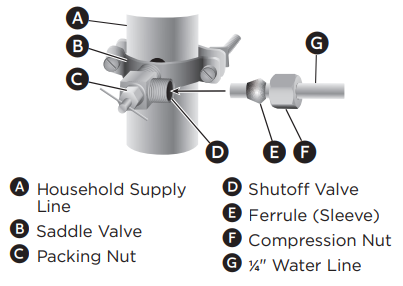
5. Slip the compression sleeve and compression nut on the water line as shown. Insert the end of the tubing into the outlet end squarely as far as it will go. Screw compression nut onto outlet end with adjustable wrench. Do not overtighten or you may crush the water line.
6. Place the free end of the water line into an empty container or sink.
7. Turn on main water supply and open shutoff valve to flush the water line of any contaminants. Run water until it is clear.
Connect Water Line to Refrigerator: IMPORTANT: If you turn the refrigerator on before the water is connected, turn off the ice maker.
1. Unplug refrigerator or disconnect power.
2. Close shut-off valve.
3. Thread a brass compression nut and ferrule (sleeve) onto the free end of the water line.

4. Insert the free end of the water line into the brass fitting attached to the water inlet on the back of the refrigerator.
5. Slide the compression nut over the ferrule and screw the nut onto the brass fitting.

6. Confirm water line is secure by gently pulling on it.
7. Turn on water supply and check for leaks. Correct any leaks.
Complete the Installation
Electrical Shock Hazard: Plug into a grounded 3 prong outlet. Do not remove the ground prong from the power cord plug. Do not use an adapter. Do not use an extension cord. Failure to do so can result in death, fire or electrical shock.
- Plug into a grounded 3 prong outlet. NOTE: This refrigerator begins operating as soon as it is connected to the power supply.
- Move the refrigerator into its final location, making sure to maintain the recommended clearance.
Level Refrigerator (if needed): The refrigerator must be level to maintain optimal performance and appearance.
- Turn the leveling feet on the bottom, front of the cabinet to raise or lower that side of the refrigerator until the refrigerator is level sideto-side.
- Turn both feet, by the same amount, to slightly raise the front of the refrigerator. This will make it easier for the doors to close. NOTE: Having someone push against the top of the refrigerator takes some weight off the leveling feet. This makes it easier to turn the feet.
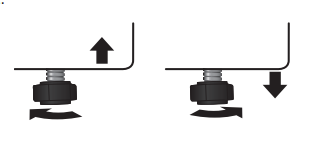
Align Doors (if needed)
If the edges of the refrigerator doors do not align with each other, you can make adjustments.
Using Adjustable Foot
- Turn the adjustable foot to raise or lower that side of the refrigerator.
- Clockwise - to raise
- Counterclockwise - to lower

Refrigerator Use
Opening and Closing Doors
The four doors can be opened and closed either separately or together.
- There is a mullion on the left-hand side refrigerator compartment door.
- When closing the left-hand door, the mullion folds behind the right-hand door joining the two doors.
- The temperature of the door frame is controlled to help prevent moisture from developing on the mullion. The temperature of the surface may be warm, which is normal, and will not affect the performance of the refrigerator.

NOTE: Before closing the left-hand door, make sure the mullion is folded inward. If the mullion is pulled outward it may become damaged when you try to close the door.

Using the Controls
NOTE: The controls on your model may look different from this and other images in this manual, depending on your model’s features
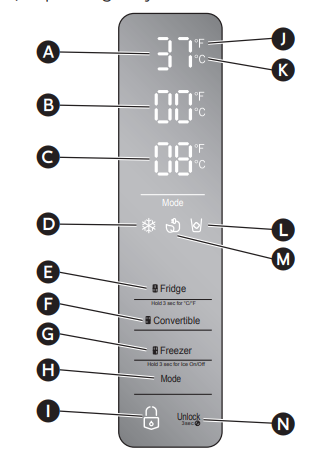
a Refrigerator Compartment Temperature
b Convertible Compartment Temperature
c Freezer Compartment Temperature
d Super Freeze Icon
e Refrigerator Temp Control
f Convertible Temp Control
g Freezer Temp Control
h Mode Control
i Lock/Unlock Icon
j Fahrenheit Indicator
k Celsius Indicator
l Ice Maker Icon
m Energy Saver Icon
n Unlock Control
Control Panel
- The display will illuminate when the refrigerator is first plugged in, a control is pressed, or a door is opened. However the lights will automatically turn off after 60 seconds.
- The Control Panel is locked, unless manually unlocked.
- NOTE: When the control panel is locked, the Lock icon
 is illuminated.
is illuminated.
To Unlock the Control Panel:
- Press and hold UNLOCK for 3 seconds. Unlock 3sec
 NOTE: When the control panel is unlocked, the Unlock icon
NOTE: When the control panel is unlocked, the Unlock icon  is illuminated.
is illuminated.
Setting Compartment Temperatures: When you set a temperature, you are setting an average temperature for the entire compartment. The actual compartment temperatures may vary from the temperatures displayed depending on the amount and placement of stored food, and the surrounding room temperature.
Recommended Temperature Settings
- Refrigerator Compartment: 37°F (3°C)
- Convertible Compartment: 8°F (-13°C)
- Freezer Compartment: 0°F (-18°C)
Display Temperatures in Degrees Fahrenheit or Celsius
- Press and hold FRIDGE for 3 seconds.
 NOTE: Either the °F or °C icon will illuminate to indicate in which scale (Fahrenheit or Celsius) the temperature is being displayed.
NOTE: Either the °F or °C icon will illuminate to indicate in which scale (Fahrenheit or Celsius) the temperature is being displayed. - Press FRIDGE again, to change the temperature scale.
Refrigerator (Fridge) Compartment Temperature
- Press FRIDGE once to turn on the temperature control.

- Press FRIDGE repeatedly to cycle through the available temperature settings, from 45°F to 34°F or from 7°C to 1°C. NOTE: Each press advances the setting by one degree.
- Release FRIDGE when the desired temperature setting appears.
Convertible Compartment Temperature
- Press CONVERTIBLE once to turn on the temperature control.

- Press CONVERTIBLE repeatedly to cycle through the available temperature settings, from 45°F to -4°F or from 7°C to -20°C. NOTE: Each press of the button advances the setting by three degrees.
- Release CONVERTIBLE to select the desired temperature setting.
Freezer Compartment Temperature
- Press FREEZER once to turn on the temperature control.

- Press FREEZER repeatedly to cycle through the available temperature settings, from 5°F to -13°F or from -14°C to -24°C. NOTE: Each press of the button advances the setting by one degree.
- Release FREEZER to select the desired temperature setting.
Ice Maker Control
- Press and hold FREEZER for 3 seconds to turn On/Off the ice maker.
 NOTE: When the ice maker is on, the Ice Maker icon
NOTE: When the ice maker is on, the Ice Maker icon  is illuminated.
is illuminated.
Additional Features
IMPORTANT: Press and hold UNLOCK for 3 seconds to unlock the control panel.
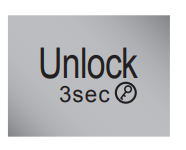
Press MODE to toggle between the Super Freeze and Energy Saver features.
Super Freeze The Super: Freeze feature rapidly lowers the freezer compartment temperature to freeze fresh food faster and maintain the temperature of the frozen food during periods of high usage, full grocery loads, or temporarily warm room temperatures. The Super Freeze feature lowers the temperature in the freezer compartment to -13°F (-25°C).
- Press MODE until the Super Freeze icon
 appears.
appears. 
- Press either the MODE or FREEZER control to manually turn off Super Freeze. NOTE: When Super Freeze is on,
 is illuminated and -13°F or -25°C appears in the temperature display.
is illuminated and -13°F or -25°C appears in the temperature display. - Press FREEZER to manually turn off Super Freeze and return to the previously set temperature. NOTE: Super Freeze will automatically turn off after several hours, and the freezer will revert to its previous temperature setting.
Energy Saver: The Energy Saver feature reduces energy use by raising the Refrigerator Compartment temperature to 43 °F (6 °C) and the Freezer Compartment temperature to 1 °F (-17 °C). IMPORTANT: The compartment temperatures in Energy Saving mode are not suitable for the storage of certain food items.
- Press MODE until the Energy Saver icon
 appears. NOTE: When the refrigerator is in Energy Saver mode,
appears. NOTE: When the refrigerator is in Energy Saver mode,  is illuminated.
is illuminated. - Press FREEZER or FRIDGE to manually turn off the Energy Saver feature.
Door Open Alarm: If a door is open for longer than 2 minutes, an alarm will sound to alert you. The alarm will sound 3 times every minute for 8 minutes.
- To turn off the alarm, close all doors completely.
Features
- Important information to know about glass shelves and covers: Do not clean glass shelves or covers with warm water when they are cold. Shelves and covers may break if exposed to sudden temperature changes or impact, such as bumping. Tempered glass is designed to shatter into many small, pebble-size pieces. This is normal. Glass shelves and covers are heavy. Use both hands when removing them to avoid dropping.
Refrigerator
IMPORTANT: To avoid damage to the doors, make sure all shelves and drawers are pushed fully into the cabinet before closing a door. Adjustable Shelves - The height of the shelves can be adjusted to fi t your storage needs.
- To remove a shelf, gently lift upward and then pull the shelf forward until the end of the shelf is past the shelf guides.
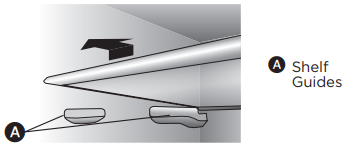
- To reinstall a shelf, gently slide the shelf back into the refrigerator compartment, and then lower the shelf onto the shelf guides so that the hooks fi t behind the rear guides.
Removable Door Bins: The bins located in the middle of the door are adjustable. To Remove and Replace a Door Bin:
- Place hands on both sides of the bin and lift upward.
- Pull the door bin out.
- Replace the door bin by inserting it above the support and pressing down to snap into place.
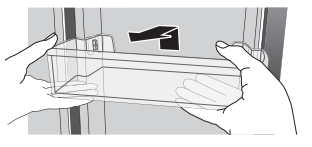
Crisper Drawers: The two crisper drawers mounted on telescopic extension slides can be used to store fruits and vegetables.
Full-width Drawer: The full-width drawer is an ideal space to store large deli platters
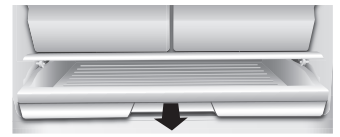
- Open - The cover automatically opens as the drawer is pulled out from the cabinet.
- Close - The cover automatically closes as the drawer is pushed into the cabinet.
Freezer
Ice Maker: Turn On/Off the ice maker by pressing and holding FREEZER for 3 seconds. The Ice Maker icon will illuminate.
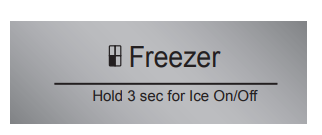
- Following installation, allow 24 hours to produce the fi rst batch of ice. Discard the fi rst three batches of ice produced. Allow 2 to 3 days to fi ll the ice storage container.
- If the ice in the ice container clumps, break up ice using a plastic utensil and discard. Do not use a sharp tool to break up the ice. This can cause damage to the ice container.
- Do not store any items other than ice in the ice storage container.
- If you will be away for an extended period of time, close the main water valve to avoid possible leaks.
NOTE: The quality of your ice will be only as good as the quality of the water supplied to your ice maker. Avoid connecting the ice maker to a softened water supply. Water softener chemicals (such as salt) can damage parts of the ice maker and lead to poor quality ice. If a softened water supply cannot be avoided, make sure the water softener is operating properly and is well-maintained.
Freezer Drawers
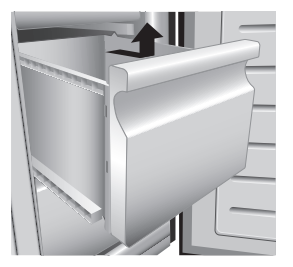
To Remove/Replace Freezer Drawer:
- Pull out drawer to maximum extension.
- Lift up to remove the drawer.
- Reverse steps 1 and 2 to replace the drawer.
General Use Information
- When first turning on refrigerator after a period of non-use, allow the refrigerator to cool at least 2 hours before adding food.
- Do not block air circulation vents with stored items.
- Store items so that the air can circulate freely around them.
- Cover or wrap stored food well to avoid transfer of odors.
- Once defrosted, food quality will deteriorate rapidly. Defrosted food should not be refrozen.
- Neither bottled nor canned drinks should be stored in the freezer compartment. Bottles and cans may explode.
Refrigerator Care
Cleaning
Both the refrigerator and freezer sections defrost automatically. However, clean both sections about once a month to avoid buildup of odors. Wipe up spills immediately. To avoid odor transfer and drying out of food, wrap or cover foods tightly
Explosion Hazard: Use nonflammable cleaner. Failure to do so can result in death, explosion or fire.
IMPORTANT:
- Do not use harsh chemicals, ammonia, chlorine bleach, concentrated detergent, solvents, abrasives or metal scouring pads to clean your refrigerator inside or out. They can damage and/or discolor the refrigerator finish.
- Do not use warm water to clean glass shelves while they are still cold. Glass may break when exposed to sudden temperature changes or impact
Electrical Shock Hazard: Unplug your appliance or disconnect power before cleaning. Failure to do so can result in death, electric shock or personal injury
- Unplug refrigerator or disconnect power.
- Clean the interior. Hand wash, rinse, and dry removable parts and interior surfaces thoroughly. Use a clean sponge or soft cloth and a mild detergent in warm water.
- Clean the door seals (gaskets). A dirty or sticky door seal may adhere to the cabinet and tear when you open the door. Using a soft cloth and a solution of mild detergent and warm water, hand wash the door seals. Rinse with clear water and dry thoroughly.
- Clean the exterior surfaces. Wash exterior surfaces with a clean, soft cloth or sponge and a mild detergent in warm water. Rinse surfaces with clean, warm water and dry immediately to avoid water spots.
- Plug in refrigerator or reconnect power.
Lights
- IMPORTANT: Your refrigerator is equipped with LED lighting. These lights are designed to last for the life of your refrigerator. However, if the lights stop operating, please contact a qualified technician for replacement.
Vacation and Moving Care
Vacation
If You Choose to Leave the Refrigerator On While You’re Away:
- Use up any perishables and freeze other items.
If You Choose to Turn Off the Refrigerator Before You Leave:
- Remove all food from the refrigerator and freezer.
- Unplug refrigerator or disconnect power.
- Clean refrigerator, wipe it, and dry well.
- Tape rubber or wood blocks to the tops of both doors to prop them open far enough for air to get in. This stops odor and mold from building up
Moving
Fire or Explosion Hazard: Do not puncture refrigerant tubing. Follow handling instructions carefully. Flammable refrigerant used. Failure to do so can result in death, explosion or fire.
IMPORTANT: Handle with care when moving refrigerator to avoid either damaging the refrigerant tubing or increasing the risk of a leak.
Excessive Weight Hazard: Use two or more people to move and install refrigerator. Failure to do so can result in back or other injury
When you are moving your refrigerator to a new home, follow these steps to prepare it for the move.
- Remove all food from the refrigerator and pack all frozen food in dry ice.
- Unplug refrigerator.
- Clean, wipe, and dry thoroughly.
- Take out all removable parts, wrap them well, and tape them together so they don’t shift and rattle during the move.
- Raise the leveling legs so they don’t scrape the floor. See “Level Refrigerator.”
- Tape the doors closed and tape the power cord to the back of the refrigerator. When you get to your new home, put everything back and refer to the “Installation Instructions” section for preparation instructions.
Reinstalling/Using Refrigerator Again
If the refrigerator has been placed in a horizontal or tilted position for any period of time wait 4 hours before plugging it in to allow the oil to settle into the compressor.
- Clean refrigerator. See “Cleaning.”
- Place refrigerator in desired location and level. See “Installation Instructions.”
- Plug into grounded 3 prong outlet.
Troubleshooting
Try the solutions suggested here first in order to avoid the cost of an unnecessary service call.
Refrigerator is Not Operating
1. Refrigerator does not run
- Refrigerator is unplugged. Plug refrigerator into a grounded 3 prong outlet.
- Breaker is tripped or turned off, or fuse is blown. Reset/Turn on breaker or replace fuse.
- Refrigerator is in defrost mode. Wait for defrost cycle to end and cooling system to restart.
2. Refrigerator compressor runs frequently or for long periods of time NOTE: This refrigerator is designed to run for longer periods of time at a lower energy usage.
- Refrigerator is first plugged in. This is normal. Allow 24 hours for the refrigerator to cool down.
- Warm or large amounts of food added. This is normal.
- Door is left open, or refrigerator is not level. Check that an item is not preventing door from closing. Level the refrigerator. See “Level Refrigerator.”
- Hot weather or frequent openings: This is normal.
- Temperature control set to coldest setting. Adjust temperature to a warmer setting.
3. Refrigerator has an odor
- Food is not sealed or packaged properly. Reseal packaging. Place an opened box of baking soda in the refrigerator, replace every 3 months.
- Interior needs to be cleaned. Clean the interior. See “Cleaning.”
- Food stored too long. Dispose of spoiled food.
4. Light does not come on
- Refrigerator is unplugged. Plug refrigerator into a grounded 3 prong outlet.
- LED light is burned out. Contact a qualified technician to replace the burned out LED.
5. Doors do not close properly
- Refrigerator is not level. See “Level Refrigerator.”
- Something is obstructing door closure. Check for and remove obstructions.
6. Vibration or rattling
- Refrigerator is not resting firmly on floor. See “Level Refrigerator.”
7. Normal Sounds
- It sounds like water is flowing from the refrigerator. Refrigerant flowing in the lines will make this sound when the compressor starts and stops. The refrigerator has an automatic defrosting system. The defrosted water will make this sound.
- Humming or buzzing sounds: The compressor and fans used for cold air circulation can make this sound. If the refrigerator is not level, the sound will be louder.
- Cracking or clicking sounds: The interior parts will make this sound as they contract and expand in response to temperature changes.
- Popping noise: May occur during automatic defrosting.
Temperature and Moisture
1. Refrigerator or freezer is too warm
- Temperature control is not set cold enough. Adjust the compartment to a colder setting; allow 24 hours for the temperature to adjust.
- Doors opened frequently or left open. Limit door openings to maintain the internal temperature. Check that an item is not preventing door from closing.
- Warm food added recently. Allow time for food and refrigerator to cool.
- The space between the back of the refrigerator and the wall is too close. Allow 2" (5 cm) space between the back of the refrigerator and the wall.
- Items against back of compartments are blocking proper airflow. Store items only inside the trim of the glass shelves; don’t place items against sides of the compartments or directly in front of any vents.
2. Refrigerator or freezer is too cold
- Temperature control is set too cold. Adjust temperature in the compartment to the next warmer setting; allow 24 hours for temperature to adjust.
3. Moisture on exterior/ interior of refrigerator
- High humidity: This is normal during times of high humidity. Dry surface and adjust temperature to a slightly colder setting.
- Doors opened frequently or left open. Keep door closed. Check that an item is not preventing the door from closing. Level the refrigerator. See “Level Refrigerator.”
- Open container of water in refrigerator: Cover or seal container
4. Frost or ice crystals on frozen food
- Freezer door left open or opened frequently. Limit door openings to maintain the internal temperature. Check that an item is not preventing door from closing.
- Refrigerator is not level. Level the refrigerator. See “Level Refrigerator.”
- Items blocking freezer air vents and preventing proper air flow. Move items away from rear wall.
5. Food freezing in refrigerator
- Food placed too close to the air vent. Move items away from back and top of the refrigerator.
- Temperature control set too cold. Adjust the temperature to a less cold setting
Ice
1. The ice maker is not producing ice, enough ice, or cubes are hollow.
- Ice maker is not turned on: Press and hold FREEZER for 3 seconds to turn On/Off the ice maker. See “Using the Controls.”
- New installation: Wait 24 hours after installation for ice production to begin.
- Kink in the water line: Straighten the water supply line.
- Inadequate water pressure: Contact a licensed, qualified plumber
See other models: RB403N4AC2 65R7E RB335N4WG1 RR27D6ASE AP1019CW1G
